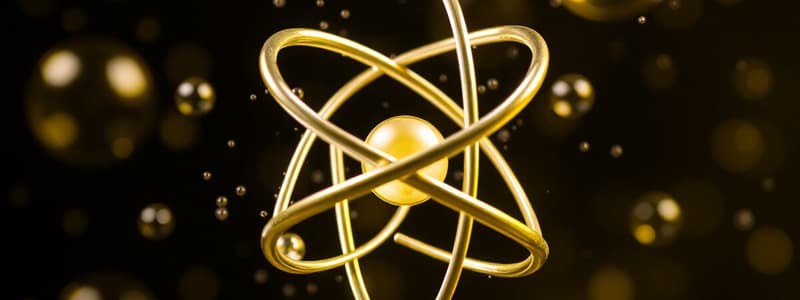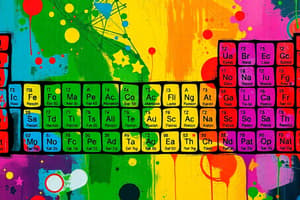Podcast
Questions and Answers
What constitutes an atom?
What constitutes an atom?
- The smallest particle of a compound that can exist.
- The building block of all compounds.
- The smallest unit of a mixture.
- The smallest part of an element that can exist. (correct)
How are compounds formed?
How are compounds formed?
- By mixing elements in any proportion.
- By chemical reactions between elements. (correct)
- By physical processes like distillation.
- Through evaporation of elements.
Which of the following is NOT a characteristic of mixtures?
Which of the following is NOT a characteristic of mixtures?
- The components are not chemically combined.
- The chemical properties of each component change. (correct)
- They consist of two or more components.
- They can be separated by physical processes.
What does a chemical symbol represent?
What does a chemical symbol represent?
How can compounds be separated into their constituent elements?
How can compounds be separated into their constituent elements?
Which of the following statements about elements is true?
Which of the following statements about elements is true?
What is a significant property of compounds?
What is a significant property of compounds?
Which of the following is a method for separating mixtures?
Which of the following is a method for separating mixtures?
In which scenario would a chemical equation be necessary?
In which scenario would a chemical equation be necessary?
What happens to the chemical properties of substances in a mixture?
What happens to the chemical properties of substances in a mixture?
What is the relative charge of a proton?
What is the relative charge of a proton?
Which statement correctly describes the overall charge of an atom?
Which statement correctly describes the overall charge of an atom?
What is the approximate radius of an atom?
What is the approximate radius of an atom?
What model was replaced by the nuclear model after the alpha particle scattering experiment?
What model was replaced by the nuclear model after the alpha particle scattering experiment?
What major contribution did Niels Bohr make to atomic theory?
What major contribution did Niels Bohr make to atomic theory?
How does an atom of one element differ from an atom of another element?
How does an atom of one element differ from an atom of another element?
What experimental evidence led to the acceptance of the nucleus in atomic theory?
What experimental evidence led to the acceptance of the nucleus in atomic theory?
What was a significant implication of the discovery of the electron?
What was a significant implication of the discovery of the electron?
What is the primary component of an atom that contains most of its mass?
What is the primary component of an atom that contains most of its mass?
Flashcards
Atom
Atom
The smallest part of an element that can exist.
Element
Element
A substance containing only one type of atom.
Compound
Compound
Two or more elements chemically combined in fixed proportions.
Chemical Reaction
Chemical Reaction
Signup and view all the flashcards
Mixture
Mixture
Signup and view all the flashcards
Chemical Symbol
Chemical Symbol
Signup and view all the flashcards
Periodic Table
Periodic Table
Signup and view all the flashcards
Separation Techniques
Separation Techniques
Signup and view all the flashcards
Scientific Model
Scientific Model
Signup and view all the flashcards
Fixed Proportions
Fixed Proportions
Signup and view all the flashcards
What is the relative charge of a proton?
What is the relative charge of a proton?
Signup and view all the flashcards
What is the relative charge of a neutron?
What is the relative charge of a neutron?
Signup and view all the flashcards
What is the relative charge of an electron?
What is the relative charge of an electron?
Signup and view all the flashcards
What is the atomic number?
What is the atomic number?
Signup and view all the flashcards
Plum pudding model
Plum pudding model
Signup and view all the flashcards
Nuclear model
Nuclear model
Signup and view all the flashcards
What evidence led to the change from the plum pudding model to the nuclear model?
What evidence led to the change from the plum pudding model to the nuclear model?
Signup and view all the flashcards
What is the Bohr model?
What is the Bohr model?
Signup and view all the flashcards
What is a neutron?
What is a neutron?
Signup and view all the flashcards
Why is the nucleus so small compared to the atom?
Why is the nucleus so small compared to the atom?
Signup and view all the flashcards
Study Notes
Atomic Structure
- All substances are made of atoms. Atoms are the smallest part of an element.
- Elements are represented by chemical symbols (e.g., O for oxygen, Na for sodium). About 100 different elements exist.
- Compounds are formed from elements through chemical reactions. These reactions involve the formation of new substances and often energy changes.
- Compounds are made of two or more elements combined in fixed proportions. They can be represented by formulas.
- Compounds can only be broken down into their constituent elements through chemical reactions.
- Chemical reactions can be shown using word equations or symbol equations.
- Students need to know the first 20 elements in the periodic table, plus groups 1 and 7.
- Students should be able to name compounds from formulas or equations.
- Students should be able to write word equations.
- Students should be able to write balanced chemical equations.
- (Higher Tier only): students should be able to write balanced half-reactions and ionic equations.
- Mixtures are made from two or more elements or compounds not chemically bonded. The chemical properties of the components are unchanged.
- Mixtures can be separated by physical processes like filtration, crystallization, distillation, fractional distillation, and chromatography. These processes do not involve chemical reactions.
- Students should be able to describe, explain, and give examples of separation methods.
- Students should be able to suggest suitable separation methods for mixtures.
Atomic Models
- Before the electron was discovered, atoms were thought of as indivisible spheres.
- The plum pudding model proposed that an atom is a ball of positive charge with negatively charged electrons embedded within it.
- Alpha particle scattering experiments showed that the mass of an atom is concentrated in a small, positively charged nucleus. This led to the nuclear model.
- Niels Bohr proposed a model where electrons orbit the nucleus at specific distances.
- Later experiments showed that the positive charge of the nucleus can be subdivided into smaller particles called protons .
- James Chadwick's work provided evidence of neutrons in the nucleus.
- Students should be able to describe the differences between the plum pudding and nuclear models.
- Students should be able to explain why the nuclear model replaced the plum pudding model.
Subatomic Particles
- Atoms have three main subatomic particles: protons (+1 charge), neutrons (0 charge), and electrons (-1 charge).
- Protons and neutrons are found in the nucleus.
- Electrons orbit the nucleus.
- Atoms have an equal number of protons and electrons, making them electrically neutral.
- The number of protons in an atom defines its atomic number, and defines the element.
- All atoms of a given element have the same number of protons
- Atoms of different elements have a different number of protons
- Atoms are very small (radius ~0.1 nm).
- The nucleus is much smaller compared to the atom (radius ~ 10-14 m).
- Almost all the mass is concentrated in the nucleus.
Studying That Suits You
Use AI to generate personalized quizzes and flashcards to suit your learning preferences.
Related Documents
Description
This quiz covers the fundamentals of atomic structure, including the properties of atoms and elements. Students will explore the formation and naming of compounds, as well as the representation of chemical reactions through word and symbol equations. Ideal for students preparing for examinations in chemistry.




